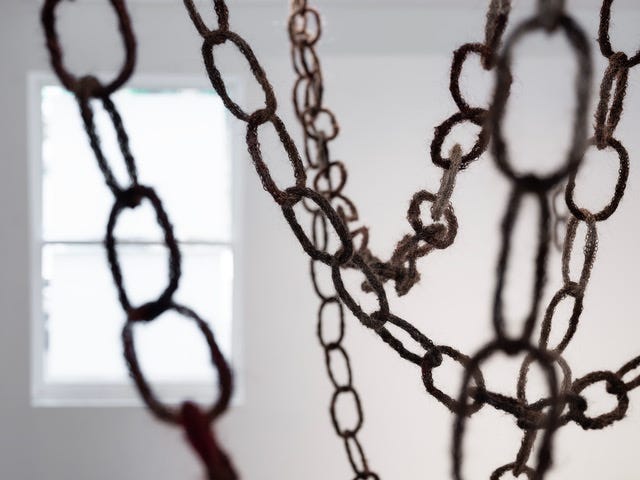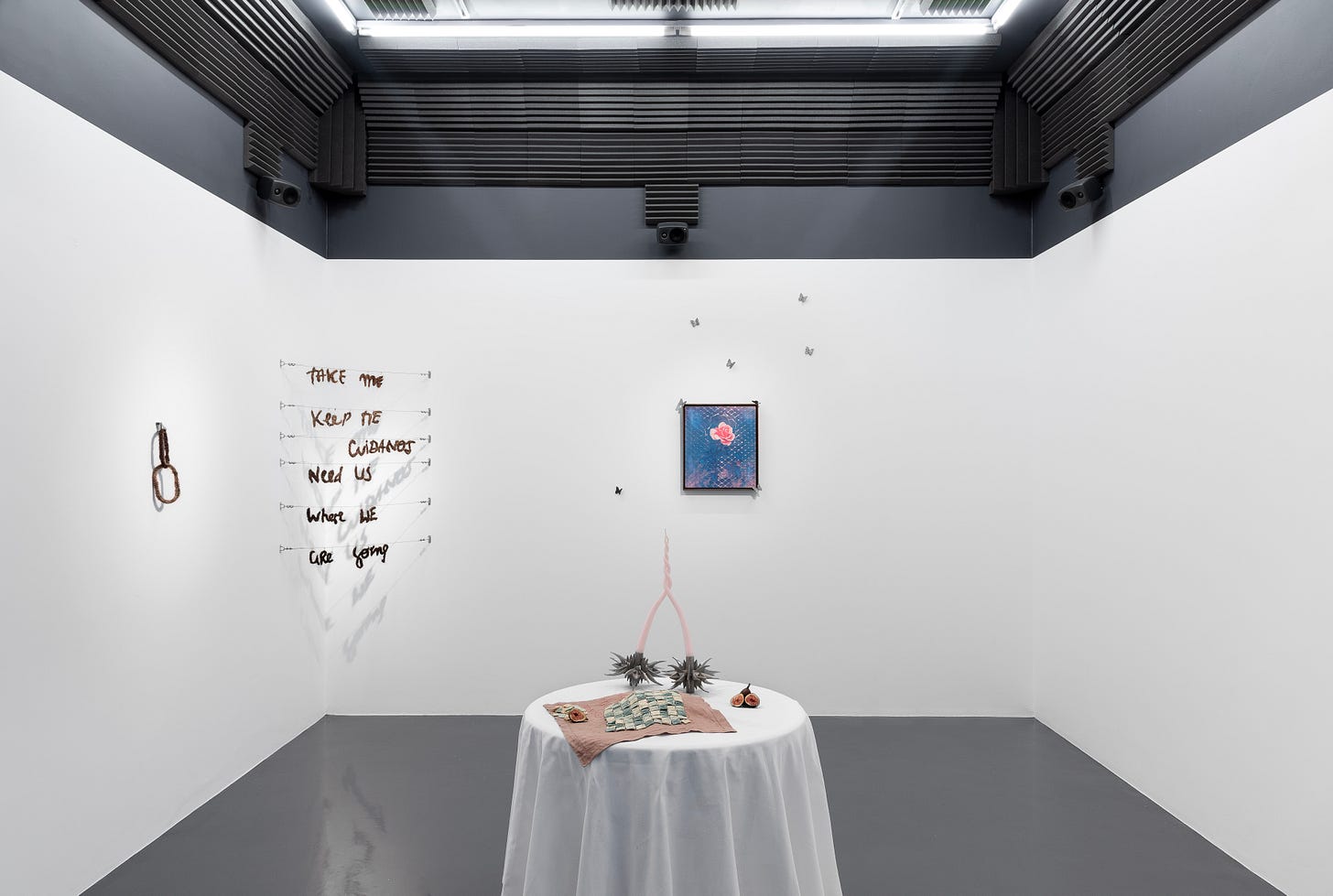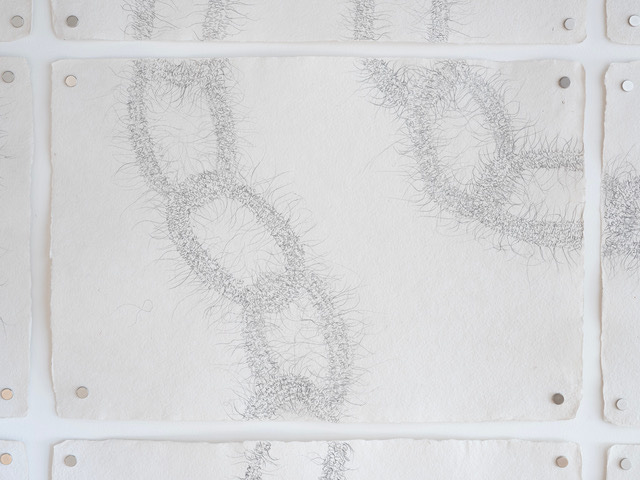Last week, I sat down with artist Belen Santamarina, who is currently exhibiting her first solo UK show Roots and Bonds at the Koppel Project here in London until the 30th of May. Belen is a truly unique artist, who has developed a fascinating practice using a variety of mediums, in particular weaving and embroidery using human hair.
Take me through your background. Where are you based, and where are you from?
“I lived in Argentina for most of my life, and moved to London around six years ago.” Belen describes. She has deep ties to family and friends back home, but at the same time she is grateful for connections built in the UK. “The difficulty is often marrying these two worlds” she explains. “I am not able to experience my life in these two places simultaneously, so I sometimes feel like they exist in separate planes of thought.”
This reminds me of the famous short story The Aleph by Argentinian author Jorge Luis Borges. In this story, the author discovers an Aleph in an acquaintance’s basement, describing it as “one of the points in space that contains all other points.” Belen’s practice appears to me, in many ways, a reflection of this interest. Her works take a collective approach, pulling together the experience of many contexts and backgrounds, and appealing to the collective experience of migration.
Belen Santamarina, Roots and Bonds, May 2025 at KOPPEL Collective. Detail of Take Me. Ph. Ollie Harrop
How long does it take you on average to complete a work? Do you think that chronology fits into the end product?
With the demand nowadays from the art market, it’s a delicate balance between putting out enough and finding the right pace. That means that there’s a sort of choice that’s made between works that have tight deadlines and works that are longer, more flowing pieces, with a sort of open timeline. For Belen, the works that take precedence in this category are tapestries. These pieces use delicate and fragile mediums such as hair to embroider; embodying a practice that is reflective and meditative.
How has your experience been preparing your show Roots and Bonds, now open at KOPPEL Collective?
“It has been a great experience thinking about the show and being able to see it come alive. The title Roots and Bonds honours hair as a link to our genealogy—not just in a personal or individual sense, but also in how it connects us to one another and shapes the societies we live in. I think of this chain as a thread tying together past, present, and future within human culture and experience.
At the beginning of the year, I received a grant that allowed me to develop this show and bring it to life as I had envisioned. It was an opportunity to develop Entanglement, the central installation, to the scale I had imagined. I wanted viewers to be able to walk around it, to see up close the many different hairs, textures, and colours woven into the work. I like the idea of looking close at something and discovering all the small, cumulative efforts required to make something. I think that’s society in its essence: everything we do has an impact, and we rely on each other.”
The drawings echo the installation and connect Belen’s interest in language, communication, and translations using hair as a vehicle. She describes: “both spoken word and hair are results of our bodies’ creation. They are called Threads as they link craft with human connection. Each drawing is made from fragments of conversations I heard from others or that I had and they range from the profound to the very random, from stories about parties to deep conversations about the meaning of life.
Finally, across the room, there is a shopping bag made out of crocheted hair and a poem. Both are meditations on care, preservation, and the act of holding and taking care of something or someone. I think about this practice of preservation as the beginning of everything. We take the time to reconsider the things we want to pay attention and to preserve in order to create the worlds we want to live in.”
Belen Santamarina, Roots and Bonds, May 2025 at KOPPEL Collective. Ph. Ollie Harrop
When did you start working with hair, and what was the motivation behind that?
It began from a few strands, and evolved from there. “The first time I worked with hair was when I saw some of my own on my sheets one day, and it inspired me. I started collecting individual pieces and trying different techniques, like spinning thread and weaving or embroidering. Then as my friends found out about my interest, and they saw my pieces, people started donating hair to me. I kept collecting, and the potential for the works grew.” describes Belen.
The strength in this medium is its rich history. Belen holds a myriad of stories in each hand as she spins together hair from heads of all different backgrounds. Seeing the way these strands form can be thrilling, especially in Roots and Bonds, where these sturdy tresses travel the space of the gallery, twisting around each other with a swinging sense of momentum.
Belen Santamarina, Roots and Bonds, May 2025 at KOPPEL Collective. Detail of Entanglement. Ph. Ollie Harrop
How do concepts like craft and science fiction play into your work?
“Science fiction is for me a way of thinking freely, beyond binary social demand and more rational linear thinking.” Belen mentions science fiction in tangent to what she describes as “the whiplash of perception”. There is a fantastical quality that is returned to her work, softening the edges of reality with a cast of characters like moths that live in symbiosis to each piece. “I find that moths are the underdogs of insects- they are intriguing, but less romanticized than butterflies,” Belen notes, discussing how these animals bend narratives and relax set norms.
Craft is integral throughout all the works that the artist creates: “I wanted to find a traditional connection to the more contemporary notes of my practice, so my older family members back home would recognize the same methods of embroidery and weaving they learned, and connect with the pieces.” The work spans many mediums, but always seems to fall back upon similar techniques that are almost reflexive or foundational in Belen’s practice.
Belen Santamarina, Roots and Bonds, May 2025 at KOPPEL Collective. Detail of Entanglement. Ph. Ollie Harrop
Working with hair seems to be almost an archival process to me, in the conservation and selection process that might go into it. Why might you choose a certain strand?
“For the most part, I have a very large supply of donations that friends and people who are interested have given me. I think part of that really comes down to seeing the way the work looked, and feeling that you might like to be a part of it, and that’s a wonderful thing. This is part of where that collective experience comes into play.” Belen points out a few presets that she has for the hair she chooses: “I’m not too selective. I feel grateful so many people keep hair for me and I am able to work with so many different hair types. Each type requires a different method or technique. Some people have very fine hair, while other have thick or curly hair, so I am always learning and thinking of new possibilities. Spinning hair, in particular, allowed me to think spatially".
Belen does sometimes use extensions, when these have been donated to her. In these instances, she notes her interest in the history of each strand. “What interests me behind used extensions is the idea of the double lived, or rewriting an experience and the intricacies behind hair as a commodity. There is such an interesting world out there in relation to the hair industry, and so many cultural and socioeconomic points that I really only learnt when I started to work with hair as an artist.” Explains Belen. She describes how hair that may be sold for commercial purposes derives from many different places, and in many conditions. An interesting example is the Hindu temples in southern India that collect donations of hair from pilgrims, who, following ancient tradition, shave off their locks at destinations such as Sri Venkateswara. The collected hair is sold to processing firms, who highly value ‘Remy’ hair, or hair cut straight from the scalp. These soon-to-be extensions and wigs will travel the globe to their new home, forming a sort of migratory and diasporic path of their own.
Belen notes: “Most people don’t like to imagine where their human extensions may come from. It makes people feel uncomfortable to remember they had a past life. But that is something to pay attention to.”
Recently you’ve also shown work in Interlaced Encounters. How has your experience been with the PACA residency, and what have you been working on?
“PACA was a great opportunity to work with other artists that really complement each other, and explore themes like identity, migration, and reimagining what frames us.” Describes Belen. The residency took place in Aix-en-Provence and culminated in Interlaced Encounters, a group exhibition curated by Federika Chaimowicz and Pilar Seivane at Lake Space in Deptford.
“In particular, I’ve spent time on this residency experimenting with new ideas and pieces like Unspoken Rituals - this is actually an ongoing work that I started on during PACA as I’m very interested in the creation or perception of languages.” In this piece, Belen encoded a message given to her by every PACA resident, making sure no-one, including her, read the contents. The information was encrypted into an alphabet of the artist’s making, and printed out onto pasta. Then the group ate the mysterious meal together, each of them sharing a potful of secrets.
At Lake Space, one of the works Belen exhibits is a relic of this last supper: in the middle of the room, a tapestry of dried leftover pasta has been intertwined into one sheet, like an impenetrable cuneiform rune.
Exhibition view, Interlaced Encounters, featuring Unspoken Rituals, Belen Santamarina
Ph. AURA Studio.
What relationship do you imagine viewers might have with your work?
“I try not to picture anything too particular. I think the more I’m able to embrace unique connections and different ways of perceiving the art, people will surprise me with how uniquely and individually they connect with the pieces.” Belen explains.
I find that every aspect of Belen’s work is angled towards an inclusive and open approach, that allows as many experiences to be framed as possible. She is interested in traditional craft and unusual narratives, and intentional in her carefully accrued medium. She looks for common footholds and bridges to weave together words, hair, and even pasta. For Belen, the common denominator is not the individual raw materials she may use or be inspired by, but the way they are sewn together into a collective story. Her impressive and adventurous use of different mediums is simply a mark of strength and flexibility.
Belen Santamarina, Roots and Bonds, May 2025 at KOPPEL Collective. Detail of Thread 11 (La Fiesta), Graphite on paper. Ph. Ollie Harrop
*Pictures courtesy of AURA Studio (Interlaced Encounters) and Ollie Harrop (Roots & Bonds).











Such a fascinating use of material (hair)! I heard recently about how, in the 1700s and 1800s, hair from relatives who had died was saved and often used in crafts, jewelry, and art as a way of keeping something tangible after a loved one had passed. Today, I could see the appeal to donating hair for the purpose of art as a way of immortalizing oneself. I wonder if the artist thinks about this, as well as the intertwining of so many different ‘strands’ of DNA into one piece, not to mention countries of origin, political views, etc. , etc. Thank you for sharing such a unique and wonderful story!